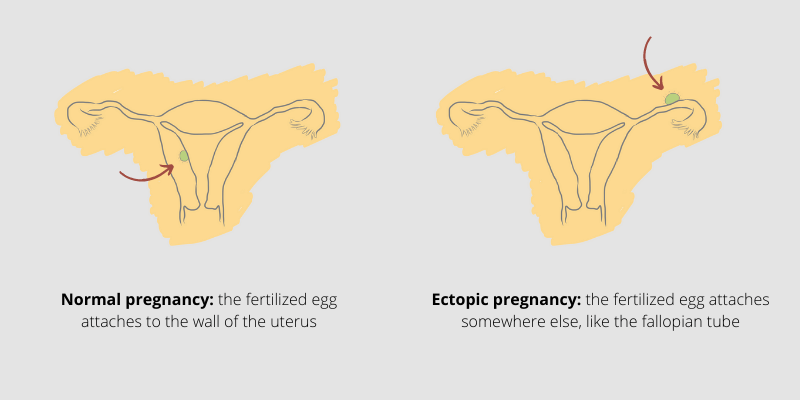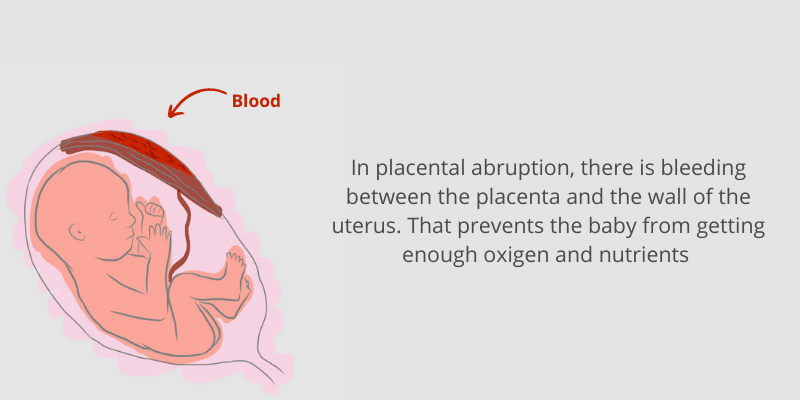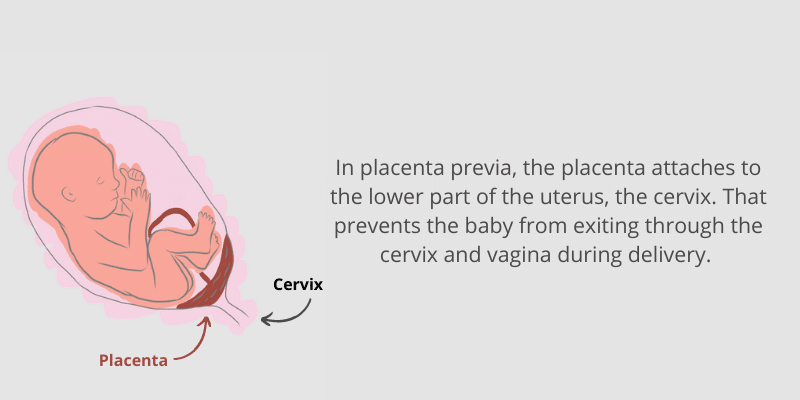Having a baby is usually great news. Unfortunately, sometimes things don’t go as we planned them… We are talking about pregnancy complications. It’s important to recognize them early so that your doctor can treat them in time.
Pregnancy complications – signs
It’s important to be aware of the “alarm” signs to detect pregnancy complications early. For this, you must be familiar with the normal signs and symptoms of pregnancy. That way, if you feel something different than that, you may suspect something’s not right. You can check our post called: Your Complete Pregnancy Guide. In the 5th section called “The 3 Trimester Timeline”, we explain how each trimester must be like.
Also, remember that most symptoms are not specific and depend on their severity. For example, it can be ok to have light bleeding (like with implantation bleeding) but not to keep bleeding profusely. Also, it’s common to feel some nausea but it’s not ok to keep vomiting all the time.
Some of the complications will endanger your baby and others both of you (mother and baby). For example, some infections can be very harmful for the baby, like toxoplasmosis or rubella, but won’t damage the mother. Other complications will pose a threat to both the mum and the baby, like placental abruption, which can cause decreased oxygen for the baby and bleeding for the mother.
The most common signs of complication are:
Bleeding. Intense painful bleeding is usually a bad thing. It may be a sign of an ectopic pregnancy, miscarriage, placenta previa…
Pain. As the fetus grows bigger it compresses the pelvic ligaments and structures and that may cause some pain. However, you should worry if the pain comes suddenly or if it gets unbearable.
What are the most frequent pregnancy complications?
· Ectopic pregnancy
Normally, the egg attaches to the inner lining of the uterus and grows there. In an ectopic pregnancy, the egg attaches somewhere else, most frequently in the fallopian tubes. If that happens, a normal pregnancy is not possible. A fetus growing inside the fallopian tube (which is thin like a straw) would tear it.

In the beginning, you will only notice that you miss your period and you’ll think you are pregnant. And you are, only the fertilized egg isn’t placed where it should. Then, you can start to experience abdominal pain and vaginal bleeding. If the fallopian tube ruptures you will feel sudden severe pain, and you may faint. You must go to the hospital immediately.
There are several possibilities for treatment. You can get expectant management, where they’ll monitor your state to make sure you recover. Sometimes they‘ll give you some medication to stop pregnancy and in severe cases, surgery may be necessary to take out the ectopic pregnancy.
· Gestational diabetes
The same as the “regular” diabetes, but it happens for the first time during pregnancy. Your insulin levels won’t be enough and so, your sugar levels will start to go up. That’s because insulin makes sugar go away from your blood (into your muscles, brain, liver…).
Typically, diabetes will cause a large baby (macrosomy). It’s like the baby would get the extra sugar. Although a big baby may seem like a good thing, it actually isn’t. Large babies can lead to C-sections and increase the risk of pre-eclampsia. To control it, your doctor will prescribe some diet and exercise. If that is not enough, you may need to get insulin injections.
Some risk factors for gestational diabetes are: obesity, other cases of diabetes in your family, and gestational diabetes in a previos pregnancy.
It usually goes away after delivery but it can happen again in future pregnancies, so be aware.
· Infections
Having active infections during pregnancy is very dangerous for your baby, especially sexually transmitted infections (STI). One infection may be harmless for you but devastating for the baby, because they are still forming.
Some infections will cause no symptoms to the mother, but then will cause terrible syndromes to the baby. That is the case for Toxoplasmosis, for example, which is harmless for the mother but can cause terrible sequelae to the fetus. The sooner the baby gets infected the worse it is, as they will be less developed.
Depending on the infection there are many risks, like:
- Miscarriage (before the 20th week) or stillbirth (after the 20th week).
- Ectopic pregnancy: if you had a pelvic inflammatory disease in the past, the infection may block your fallopian tubes. Then, the egg won’t be able to travel through it and will get stuck there, causing an ectopic pregnancy.
- Preterm labor
- Low birth weight
- Birth defects and malformations: blindness, deafness, bone deformities, mental retardation…
- Serious illness the first weeks: the baby may be born with severe pneumonia, chorioretinitis…
The Classical Congenital Infections
There is a famous acronym for classic congenital infections: TORCH. Each letter stands for a different infection as you can see in the next graphic.

Each of the infections can cause the following disorders:
- T – toxoplasmosis: hydrocephalus, intracranial calcifications, chorioretinitis. Stay away from cats, as they can spread Toxoplasma through their feces.
- O – others: it includes syphilis, HIV… Syphilis can cause several malformations such as Hutchinson teeth, saddle nose… but also deafness, keratitis, and other complications
- R – rubella: typically causes rash, cataracts, and retinopathy.
- C – cytomegalovirus (CMV): intracranial periventricular calcifications, hepato-splenomegaly (huge liver and spleen).
- H – Herpes Simplex Virus (HVS): it causes a skin disease with rash and vesicles, cataracts, seizures, and pneumonia.
To prevent these terrible pregnancy complications, it’s important to treat any active infections you may have. Also, if you are planning on getting pregnant make sure to have all your vaccines up to date.
· Hyperemesis gravidarum
It’s the Latin name to say “you vomit all the time”. It’s common to feel nausea and vomit sometimes during the first trimester, that is not a disease. However, with hyperemesis gravidarum, you just can’t stop vomiting. It may last all the pregnancy or improve after the 20th week.
If you experience it you should go to the hospital. All the vomiting can make you dehydrated. There, they can give you IV fluid and medication to stop the vomiting.
· Miscarriage
It’s a pregnancy loss before the 20th week. The signs of a miscarriage are abdominal pain, vaginal bleeding and fluid coming out from the vagina.
· Stillbirth
It‘s similar to a miscarriage but after the 20th week. It can be due to many causes, like chromosomal abnormalities, placental problems… However, in many cases, the cause cannot be determined.
· Gestational Hypertension
It’s high blood pressure during pregnancy in a woman that was not hypertensive before. It usually happens in the second half of pregnancy . High blood pressure can make it hard for blood to reach the placenta, where your baby gets the oxygen and nutrients from. Thus, it can cause preterm labor and preeclampsia.
To control it, you have to check your blood pressure regularly, especially in the second half of pregnancy. If it gets very high your doctor may need to prescribe some pills. Fortunately, it usually goes away after delivery.
· Preterm labor
Birth usually happens at around 39 and 40 weeks. It is considered preterm labor when it happens before the 37th week.
The problem with these babies is that their lungs are not fully developed. Their lungs lack a substance called surfactant. This substance is necessary for the right distension of the lungs. And it is produced between weeks 24 and 37. Without the right amount of surfactant, there is a risk for hyaline membrane syndrome. With this syndrome, the baby has difficulty breathing.
The best way to prevent it is by avoiding preterm labor. But if preterm labor is imminent, giving the mother corticoids will dramatically reduce the chances of the syndrome.
· Pre-eclampsia
Pre-eclampsia is a condition consisting of high blood pressure and protein loss in urine. The protein loss causes other abnormalities, such as swollen legs, headache, and dizziness.
It usually happens at the end of pregnancy and resolves with delivery. If pre-eclampsia is not controlled it evolves into eclampsia.
Eclampsia is a severe condition characterized by 3 items: high blood pressure, protein loss in urine, and. seizures.
Eclampsia is very dangerous for both the mother and the baby because seizures can prevent oxygen from reaching the baby.
If you feel any of the mentioned symptoms, go to your doctor. They will measure your blood pressure and maybe run a urine test. If the pressure is high or if there are proteins in your urine, the next step depends on which week you are in. After the 37th week, the baby is already developed and labor induction is a good option. If the baby is still immature (< 36th week) and you have mild pre-eclampsia then your doctor can choose to wait and observe. You will be admitted to the hospital and they will check your constants. If it gets worse, they will induce labor or perform a C-section.
If you have eclampsia with seizures, you need to deliver right away. Even if the baby is not on term. After all, if the mother isn’t safe the baby won’t survive either. After urgent delivery or C-section, the baby will receive special care to get a full recovery.
· Abruptio Placentae
Also called placental abruption, it’s a complication of the last weeks of pregnancy. The placenta is the organ through which your baby gets oxygen and nutrients and it’s firmly attached to the wall of the uterus. There, it gets oxygen and nutrients from the mother’s blood and passes them to the fetus.
During a placental abruption, there is bleeding between the placenta and the wall of the uterus. This blocks the baby’s supply of oxygen and nutrients. Without oxygen there is a risk for preterm labor and restricted growth…

Also, the mother is at risk too, because the bleeding can get her in a shock state (from a sudden blood loss ). The symptoms of placental abruption are:
- Vaginal bleeding: although not always, as sometimes the blood remains beneath the placenta.
- Abdominal and back pain: it is a sudden pain.
- Uterine contractions: usually one right after another.
If you feel these symptoms, go to your hospital immediately. If there’s a risk for the baby and mother they will have to induct delivery.
· Placenta previa
It happens when the placenta “blocks” the exit of the baby from the uterus. Usually, the placenta attaches to one side of the wall of the uterus. Placenta previa means that the placenta is located against the cervix (the channel where the baby will come from).

It can cause bleeding, both during pregnancy and labor. The placenta can change its position with time. But if it remains attached to the cervix, then the doctor will have to perform a C-section to deliver your baby.
Leave a Reply